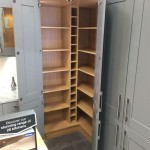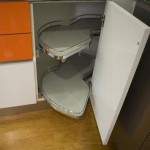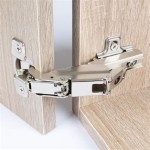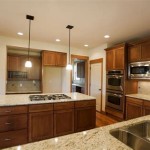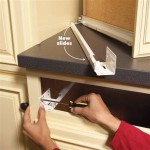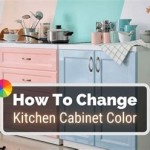How Blind Corner Cabinets Function
Blind corner cabinets, frequently found in kitchen designs, present a unique storage challenge. These cabinets are located in the intersection where two runs of cabinetry meet at a right angle, resulting in a portion of the cabinet space being difficult to access using conventional methods. Understanding the mechanisms and options available for blind corner cabinets allows homeowners and designers to maximize storage capacity and improve kitchen functionality.
The fundamental problem with blind corner cabinets is the significant portion of space that remains hidden and hard to reach. Standard shelving placed within this area often results in items being pushed to the back and essentially lost. This inaccessible space can be a source of frustration and represents a significant waste of potential storage. To combat this, specialized hardware and design solutions have been developed to make accessing and utilizing this space more efficient.
Understanding the Basic Design Challenges
The primary challenge is the depth and location of the blind space. This area extends beyond the reach of a standard cabinet opening and typically lacks sufficient light, exacerbating the difficulty of identifying and retrieving stored items. Furthermore, the awkward angles created by the corner configuration make it challenging to maneuver items in and out of the cabinet.
Cabinet design also plays a critical role. The size and shape of the cabinet opening significantly impact the usability of the blind corner. Some cabinets have very narrow openings, further restricting access. The location of the adjacent cabinet also influences how easily one can reach into the blind space. Consequently, careful consideration must be given to cabinet dimensions and placement during the kitchen design process.
Traditional shelving alone is often insufficient. Without a mechanism to bring items from the back of the cabinet to the front, the blind corner becomes a dumping ground for infrequently used items. This leads to clutter, disorganization, and wasted space. The need for specialized solutions is therefore paramount in optimizing the functionality of blind corner cabinets.
Common Blind Corner Solution Mechanisms
Several mechanisms have been developed to address the accessibility issues of blind corner cabinets. These mechanisms can be broadly categorized into pull-out shelving systems, swing-out shelving systems, and lazy Susan configurations. Each approach offers different advantages and disadvantages in terms of space utilization, ease of use, and cost.
Pull-Out Shelving Systems: These systems typically consist of a set of shelves or baskets that slide out of the cabinet, bringing the contents of the blind corner into view and within easy reach. The shelves are mounted on glides, allowing for smooth and effortless operation. Pull-out systems are available in various configurations, including full-extension glides that allow the shelves to be pulled out completely, providing unobstructed access to all items stored on the shelves.
Many pull-out systems feature tiered shelving, maximizing vertical space and allowing for the storage of items of varying heights. The ability to adjust the height of the shelves is also a common feature, providing further customization to suit individual storage needs. Weight capacity is another important consideration, as some systems are designed to hold heavier items such as pots and pans.
Swing-Out Shelving Systems: Similar to pull-out systems, swing-out shelves bring items from the back of the cabinet to the front. However, instead of sliding out in a linear fashion, the shelves swing out on a pivot point. This allows for a wider range of motion and can provide better access to items stored on the sides of the shelves. Some swing-out systems feature multiple tiers of shelves, each of which can be independently swung out of the cabinet.
Swing-out systems are often designed with a door that is attached to the shelving mechanism. When the door is opened, the shelves automatically swing out, providing immediate access to the stored items. This integrated design can be both convenient and aesthetically pleasing. However, the swing-out motion may require more clearance space in front of the cabinet compared to pull-out systems.
Lazy Susan Configurations: Lazy Susans are rotating shelves that allow users to access items from all sides of the cabinet simply by rotating the shelf. In the context of blind corner cabinets, Lazy Susans are typically designed with a pie-cut shape to fit within the angled space. This configuration allows for efficient use of the corner space while providing easy access to the stored items.
Lazy Susans are available in various materials, including plastic, wood, and metal. The weight capacity and durability of the material are important considerations, especially for storing heavier items. The rotation mechanism should also be smooth and reliable, ensuring that the shelf can be easily rotated even when fully loaded. While traditionally round, Lazy Susans designed for blind corners are often kidney-shaped or have other specialized geometries to maximize space utilization.
Factors to Consider When Choosing a Blind Corner Solution
Selecting the appropriate blind corner solution requires careful consideration of several factors, including the size and configuration of the cabinet, the types of items to be stored, the budget, and the desired level of accessibility. A thorough assessment of these factors will help to ensure that the chosen solution effectively addresses the specific storage needs and preferences of the homeowner.
Cabinet Size and Configuration: The dimensions of the blind corner cabinet are a primary determinant of the type of solution that can be implemented. Smaller cabinets may be limited to simpler solutions such as Lazy Susans, while larger cabinets may be able to accommodate more complex pull-out or swing-out systems. The shape of the cabinet opening and the presence of any obstructions also need to be taken into account.
Storage Needs: The types of items to be stored in the blind corner will influence the choice of shelving system. For example, if the cabinet is intended for storing heavy pots and pans, a robust pull-out system with a high weight capacity may be the most suitable option. If the cabinet is intended for storing smaller items such as spices or canned goods, a Lazy Susan or a tiered pull-out system may be more appropriate.
Budget: The cost of blind corner solutions can vary significantly depending on the complexity of the mechanism and the quality of the materials. Simple Lazy Susans are typically the least expensive option, while more elaborate pull-out and swing-out systems can be considerably more expensive. It is important to establish a budget and explore the options that fall within that range.
Accessibility Preference: Some solutions offer better accessibility than others. Full-extension pull-out systems provide the most unobstructed access to stored items, while Lazy Susans require the user to rotate the shelf to locate and retrieve items. The level of accessibility required will depend on the frequency with which the items in the blind corner are used and the physical capabilities of the user.
Installation Complexity: The complexity of installation can also be a factor to consider. Some solutions, such as Lazy Susans, are relatively easy to install, while others, such as pull-out and swing-out systems, may require more specialized skills and tools. It is important to assess the level of difficulty of installation and determine whether professional installation is necessary.
Beyond these mechanical solutions, the strategic placement of items can also improve usability. Storing infrequently used items in the farthest reaches of the blind corner and placing frequently used items closer to the front of the cabinet can minimize the need to reach into the inaccessible areas. Similarly, using clear storage containers can make it easier to identify the contents of the cabinet without having to pull everything out.
Light is also an important consideration. Adding a light inside the blind corner cabinet can significantly improve visibility and make it easier to find items. Battery-operated LED lights are a convenient and cost-effective option, while hardwired lights provide a more permanent and reliable solution.

Blind Corner Cabinets Step By Guide On How To Install

What Is A Blind Corner Cabinet The Homestud

Blind Corner Cabinets Step By Guide On How To Install

How To Make Blind Corner Cabinet Space More Useful

Change The Way You Use Blind Corner Cabinets Mecc

Blind Base Cabinets 101

What Is A Blind Corner Cabinet The Homestud

Diy Corner Cabinet With No Wasted Space Sawdust Girl

Blind Corner Base Cabinet Dimensions Ultimate Guide 2025

Shaker White 42 Blind Base Corner Cabinet
Related Posts

